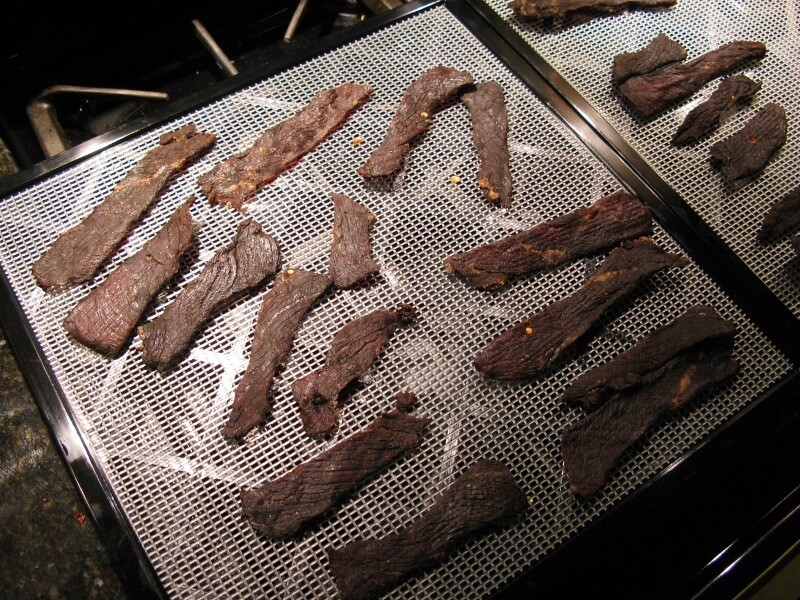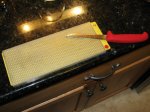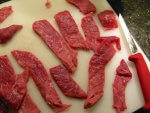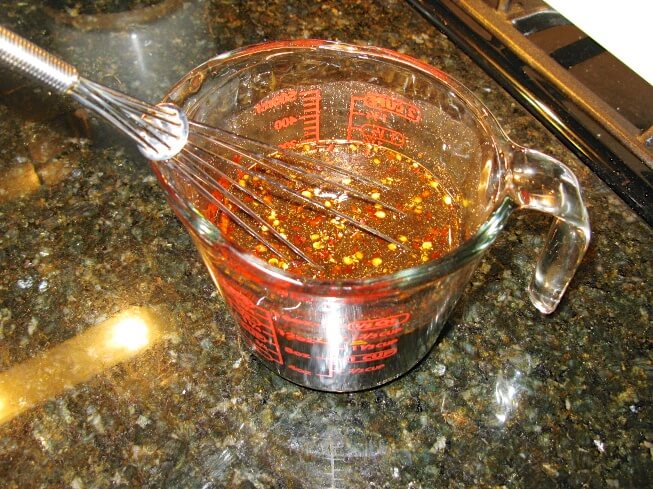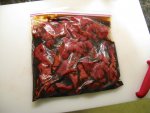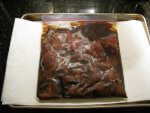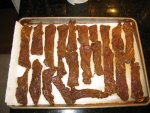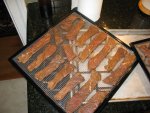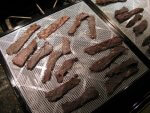My good friend Jack gave me a dehydrator as a wedding gift (guys just know how to give good gifts!). What is the perfect thing to use it for? Jerky! That portable meat product that is always satisfying, low in fat, has about zero carbs and is full of flavor!
As a typical food geek, I had to research the art and science of making jerky and want to share the highlights and outcome.
The Meat
Jerky is a preserved meat product that is tough by intention. The ideal meat for making beef jerky then is any cut that has a uniform muscle shape, little if any gristle and is not well marbled (fat content in the finished product will reduce the shelf life).
The reason for the uniform muscle shape is that you want to be able to cut your strips of jerky with the grain of the meat, so the muscle fibers run the length of the jerky you are making. If you have a cut of meat with the grain running not with the length of the cut (say a New York Strip) your finished jerky will break apart easily.
Luckily there are some cheap cuts that have long muscle fibers, little fat and little gristle. These are: Flank Steak (aka London Broil) and Bottom Round (the bottom round roast has very straight grain – you can really tell what I mean by grain by looking at the image linked to). Regardless, grab either two pounds of flank steak, London broil or bottom round, whichever is on sale.
The Marinade
As an aid in flavor and an essential element in preservation, jerky is marinated prior to drying. Though any high salt acidic liquid will do, you want something that tastes good (and what tastes good to you may not taste good to others, so feel free to make your own mixture up!).
Here are two that I tried and my take on them:
From Alton Brown of “Good Eats”:
- 2/3 cup Worcestershire sauce
- 2/3 cup soy sauce
- 1 tablespoon honey
- 2 teaspoons freshly ground black pepper
- 2 teaspoons onion powder
- 1 teaspoon liquid smoke
- 1 teaspoon red pepper flakes
This is a very “Worcestershire” strong marinade. It made great jerky, but the Worcestershire flavor was a bit too strong.
My own concoction after experimenting:
- 1 cup soy sauce
- 2 tablespoons Worcestershire sauce
- 2 tablespoons honey
- 1 tablespoon good balsamic vinegar
- 1 teaspoon quality black pepper
- 2 teaspoons granulated onion
- 2 teaspoons granulated garlic
- 1 teaspoon sweet paprika
- 1 tablespoon Bragg’s “Liquid Aminos All Purpose Seasoning“
- 2 tablespoons Liquid Smoke (I like to make my own but if you do make your own, use just a few drops as what is sold in stores is very diluted. Also, if you make your own, add white vinegar to make up the needed 2 tablespoons ..you need it for acidity)
- 1 tablespoon crushed red pepper flakes
The Bragg’s seasoning is in the health food section of your local big box retailer. You can omit it if you like, but it is a great addition. You could also swap out the Soy sauce and the Bragg’s amounts and have a slightly lower sodium level, but a slightly more mellow flavor).
This makes a smoky semi-sweet, lightly spicy jerky that I love. All who have tasted it think it is the best they have had. For a sweeter version I add a cup of brown sugar..YUM!
As always…don’t be a stubborn recipe follower. If you use enough salty/sweet and acidic ingredients (here that is honey, liquid smoke and vinegar – all of which have a PH below 4.5 with the honey being the most acid oddly enough), the sky is the limit. This is also why you add the vinegar if you use pure liquid smoke. You can try jalapeños, brown sugar, teriyaki sauce, Tia chillies or anything that suits you. You can get thousands of recipes from the Internet as well. The key is to use flavor elements that suit your preference. See “Food Safety” for more information.
The Prep
Place your meat in the freezer for an hour at least. It will slice thinner and more consistently when near frozen.
While the meat chills, sharpen your knife. I use a diamond stone from DMT (the 10″ DuoSharp Bench Stone). It is outrageously expensive, but after 20 years of use, it is actually inexpensive in the long run. I also use a cheap boning knife that can be sharpened to death and not cause me any grief when I have to toss it out.
With chilled meat and a sharp knife, slice with the grain into thin strips (1/8″ to 1/4″). Remove any excessive fat, gristle or veins. Slicing with the grain will give you chewy jerky. You can slice against the grain for “crumbly” jerky.
Once sliced, place in a freezer bag and add the marinade and let soak for six hours. Mix it around by squishing the bag back and forth every hour or so.
Remove and allow to dry on paper towels (this is really optional, as you can just put the wet strips onto the drying racks…it adds more flavor and is what I do if I have a lot of granulated spices in the mix that I want to capture onto the jerky).
The Drying
Place the marinated meat on the racks of your dehydrator and set it according to the manufacture’s directions for jerky. For me and mine, I ran it at 155 degrees for six hours. This made a very dry product (the way my daughter likes it). For me, I like it a bit softer, so I pull mine at five hours.
Food Safety
If you want to keep reading, here is a bit on safety. So what have you really made? Is this stuff safe to take on a two week camp out? Likely. Can you put it in your bomb shelter and expect to have a source of food for years to come? Not likely. The methods of preservation at play here are drying, acidification and cooking (the 155 degrees).
You want to think about various biological hazards and how they are controlled. E. Coli (O157:H7) is controlled with a water activity (think dryness…more in a bit) of .95, a heat of 70C/158F or a PH of 4.4. Salmonella is controlled with a water activity of .94, the same level of heat and a PH of 3.8. Staphylococcus aureus is controlled with a water activity of .85, a heat of only 60C/140F and a PH of 4.0.
So, is your final jerky past these minimal thresholds? Let’s look at each one:
Water Activity: USFDA uses water activity as a rating tool to measure/establish the shelf stable aspects of food. Simply stated water activity is a percentage number of the water vapor pressure in a given product relative to pure water at the same temperature So, pure water would have a water activity of 1. The air your breath is about .7, cereal is about .6, honey is .5 and dried fruit is about .6. In essence then, water activity is simply a way of stating how much moisture has been removed, relative to absolute water.
PH: Many of the items added to the marinade or “cure” for the jerky are simply to get the PH down. Vinegar and Honey are the chief items here. Vinegar can have a PH from 2.4 to 4.5 depending on what you use. If you use Soy Sauce, again you have a great acid at about 4.8 PH. So the marinade/cure mentioned here has a very acidic PH.
Temperature: My dehydrator sits at 155 degrees F at its highest setting. Not enough to get to the magic 160.
So your honey is “shelf stable” even after opening because it has a water activity of .5 and a PH of about 4.0. At these levels, it limits the growth of the above mention biological hazards.
Can you say the same about your jerky? The truth is you can’t without expensive measuring equipment. If you used a salty/sweet marinade with a low PH, then you are assuming that you have a PH down below 4.5 and a water activity of less than .7. At that point, you should be able to vacuum seal the jerky and have it keep for months. If you don’t vacuum seal it, and store it in an “almost” air tight container, the water from the air that it has access to will migrate from the air to the jerky, reducing shelf life.
In the end I recommend the following: Consume the jerky you make in two weeks. If you want to keep it for an extended period of time, vacuum seal it. Thus sealed, it should stay within the USFDA’s guidelines for several months (low PH and low Water Activity). Additionally, you can freeze the vacuum packed jerky to extend that period immensely.
To hedge my bets, I add Sodium Nitrite (aka Prague Powder) to my marinade at the same rate used in making sausage, 1 teaspoon per 5 pounds of meat. If you look at the ingredients of most commercial jerkies you can buy, you will see Sodium Nitrite listed for the same reason. With this added, I am comfortable vacuum bagging the product and give it a non-refrigerated shelf life of six months. It never actually lasts that long!
